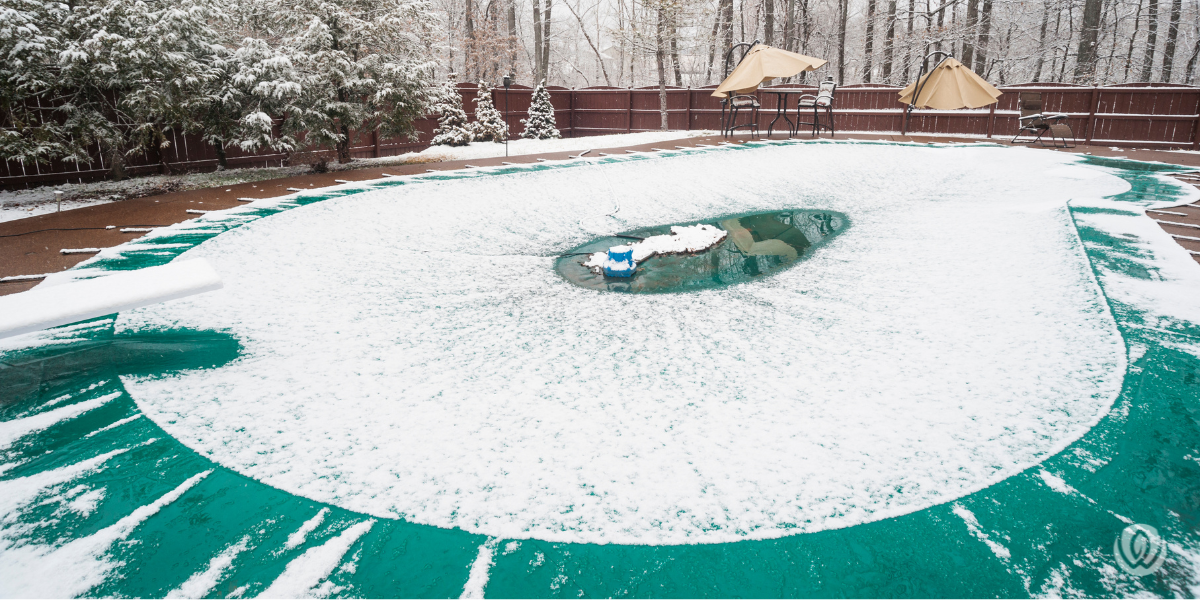
At LiveWell Outdoors, we believe in turning every backyard into a luxury oasis, where pools often serve as the centerpiece of relaxation and leisure. But as seasons shift, so do the needs of your pool. Winterizing isn't just a customary step; it's a rite of passage for every pool owner to ensure their sanctuary remains pristine even through the harshest winter months. By properly closing your pool for the winter, you shield it from potential damage and pave the way for a hassle-free open when summer comes back around.
Dive into our comprehensive guide and discover how to winterize an above-ground pool and indoor pool. By properly closing pools for the winter season, we guarantee every summer plunge is as refreshing as the first.
Pools are a blast in the summer, and we must guarantee they're taken care of when the cold weather rolls in. Here's why:
The water inside can freeze if you don't winterize your pool. This frozen water could harm the pool's structure and equipment. That's why it's crucial to know how to winterize an inground pool or an above-ground pool based on what you have.
Winterizing also means keeping the pool's water clean. Without a proper closing pool for the winter checklist, leaves and other stuff can dirty the water, making it a much bigger job to open your pool for the summer.
If you've taken care of winterizing your inground pool or above-ground pool, starting it up again for the following summer will be much easier. You won't have to clean as much or fix broken things, and you can jump in sooner!
Winterizing your pool is like tucking it in for a long nap. You must help your pool wake up refreshed, undamaged, and ready to provide endless summer fun.
Getting your inground pool ready for winter? It's not just about throwing on a cover and calling it a day. You must follow some crucial steps to ensure your pool is safe and ready for the following summer.
Before starting the process to winterize inground pools, ensure the water's chemistry is just right. Check and balance the pH, alkalinity, and calcium hardness levels.
By balancing your pool, you will better protect it from algae growth and potential damage during the winter months.
Clean out everything that's fallen into the pool. You'll want to remove leaves, bugs, and any other debris before covering it up.
When you winterize an inground pool, using a pool vacuum can make cleaning a lot faster and easier. Make sure you cover every inch of the pool and get into those corners!
When prepping your pool for winter, it's essential to lower the water to the right level. This level will vary depending on your pool's design and where you live.
Once you've cleaned and adjusted your pool's water, it's time to put on the winter cover. This cover keeps out debris and protects the pool from harsh weather.
Also, don't forget about your equipment! Drain and winterize pumps and heaters to keep them safe during the cold months. Protective covers for your pool equipment can help extend their lifespans and keep them working efficiently.
Following these steps to winterize an inground pool is essential. By guaranteeing everything is in order, you'll pave the way for a hassle-free and inviting pool experience come summer. Next, we'll tackle preparing above-ground pools for the chilly months ahead.
If you're winterizing an above-ground pool, the steps are similar to those of an above-ground pool. However, there are some specific details you'll want to pay attention to.
While the basics of pool chemistry remain the same, above-ground pools might have slightly different needs than their inground counterparts, especially regarding water balance and chemical types.
Regularly test the water to maintain proper pH, alkalinity, and calcium hardness levels, ensuring your pool is primed and ready for the winter.
For above-ground pools, skimmers and brushes are your best friends. They help scoop out leaves, bugs, and other debris, ensuring clean water and surface.
A well-cleaned pool minimizes the chances of algae growth and liner damage during the winter months. It also makes opening the pool much easier when the time comes.
Like inground pools, you'll want to lower the water level in an above-ground pool, but not too much. Always ensure the water is below the skimmer but covers the pool's liner.
Liner plays a critical role in above-ground pools. Maintaining the right water level helps protect the liner from potential damage or displacements during the frosty months.
Once you've finished the closing pool for the winter process, ensure that all accessories like ladders and floats are cleaned, dried, and stored in a dry, safe place.
It's also essential to drain, clean, and store your pumps and filters in a location where they won't freeze or get damaged.
Taking the time to winterize an above-ground pool properly ensures a quicker, seamless start to the next swimming season, keeping your backyard oasis in top shape year after year.
When winterizing, the pool cover is like a shield, protecting the harsh winter elements. Here's how to guarantee you've got the right cover and it's correctly placed:
Whether you're looking at winterizing an inground pool or an above-ground pool, the type of cover you choose will differ. It's vital to pick the right one tailored to your pool's specifics.
Beyond just protecting your pool from debris, a safety cover provides an added layer of protection, preventing accidental falls or unwanted access to the pool during the offseason.
A well-fitted pool cover minimizes the chances of it being blown away by strong winds or getting weighed down by water or snow. Ensure it's tightly secured all around your pool.
Regularly check for any signs of wear and tear. Avoid sharp objects or chemicals coming in contact with the cover to increase lifespan.
Just because your pool is closed for the winter doesn't mean you can forget about it. Regularly inspect your cover and pool for any signs of damage or issues.
For instance, heavy snow or ice can put undue stress on your pool cover. After heavy snowfall, gently remove excess snow using a soft broom or tool, ensuring you don't damage the cover.
The peace of mind from a properly winterized pool is invaluable. Your pool is a significant investment, and it feels good to protect it. As you check out your securely covered pool during winter, you can anticipate a more effortless pool opening when the summer sun returns.
As the seasons change, your pool's care and preservation reflect your love for your backyard haven. At LiveWell Outdoors, we're passionate about helping you achieve and maintain that luxurious outdoor experience, no matter the season.
We're experts in creating spectacular outdoor living spaces that cater to every backyard dream. Check out our portfolio and imagine what we can do together to transform your backyard into the perfect oasis. When you're ready to start, schedule a consultation; we can't wait to hear from you!
